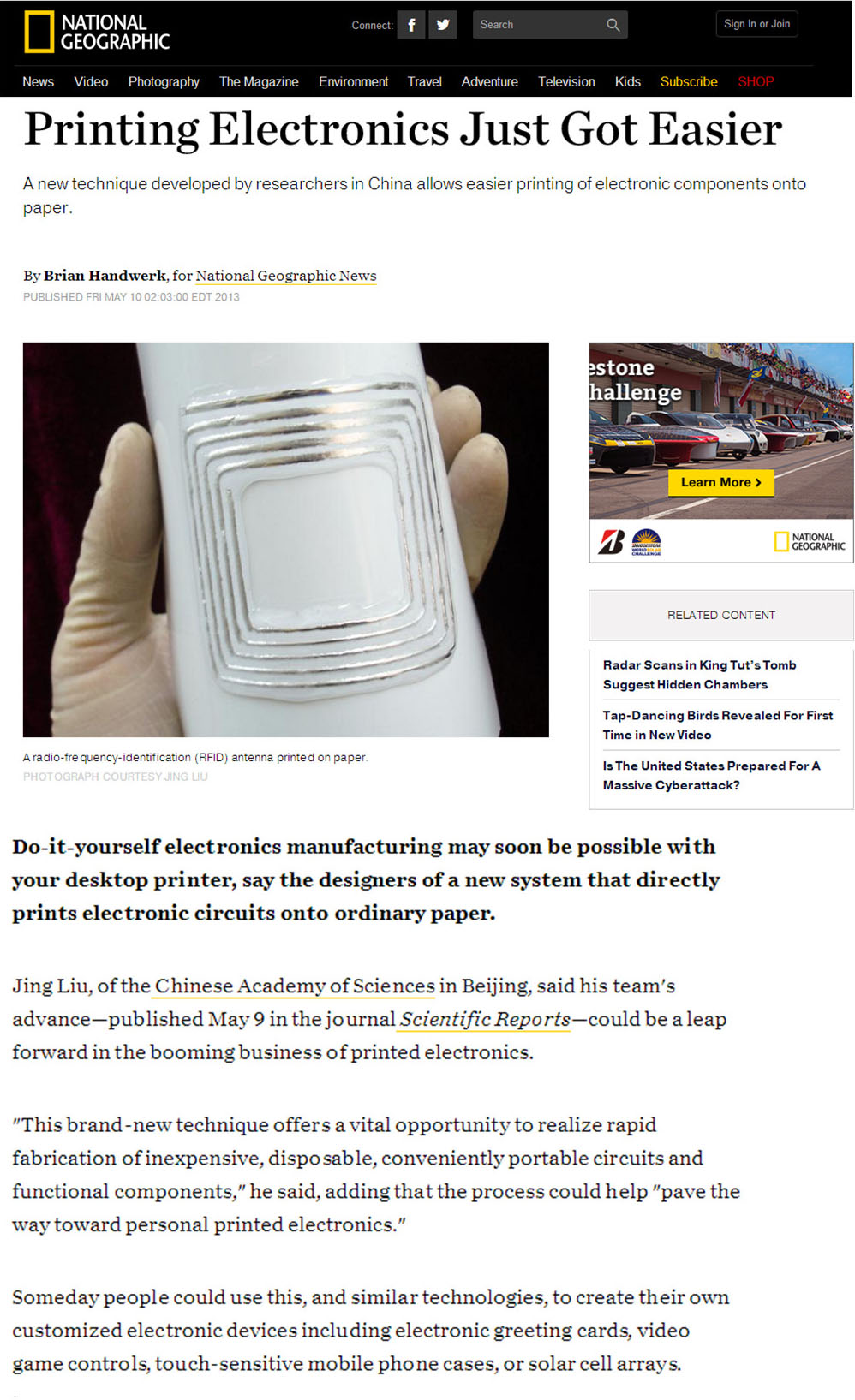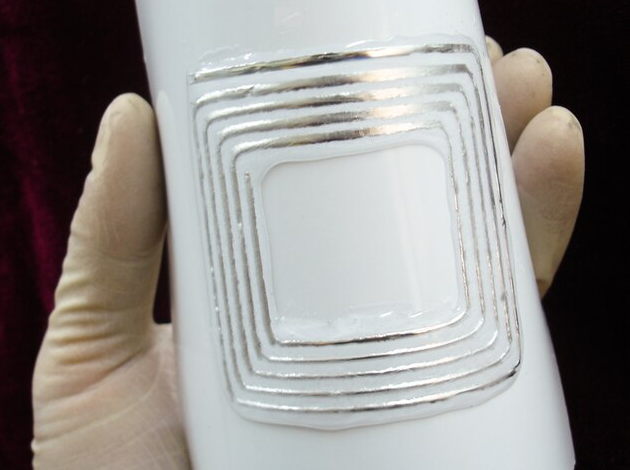国际知名杂志《国家地理科学栏目》报道液态金属桌面电路打印技术
- 分类:公司新闻
- 作者:
- 来源:
- 发布时间:2022-09-02 14:27
【概要描述】A new technique developed by researchers in China allows easier printing of electronic components onto paper.
国际知名杂志《国家地理科学栏目》报道液态金属桌面电路打印技术
【概要描述】A new technique developed by researchers in China allows easier printing of electronic components onto paper.
- 分类:公司新闻
- 作者:
- 来源:
- 发布时间:2022-09-02 14:27
- 访问量:

Printing Electronics Just Got Easier
A new technique developed by researchers in China allows easier printing of electronic components onto paper.

Do-it-yourself electronics manufacturing may soon be possible with your desktop printer, say the designers of a new system that directly prints electronic circuits onto ordinary paper.
Jing Liu, of the Chinese Academy of Sciences in Beijing, said his team's advance—published May 9 in the journal Scientific Reports—could be a leap forward in the booming business of printed electronics.
"This brand-new technique offers a vital opportunity to realize rapid fabrication of inexpensive, disposable, conveniently portable circuits and functional components," he said, adding that the process could help "pave the way toward personal printed electronics."
Someday people could use this, and similar technologies, to create their own customized electronic devices including electronic greeting cards, video game controls, touch-sensitive mobile phone cases, or solar cell arrays.
Scientists already print electronic circuits on flexible materials like plastics that can be shaped into functional products—antennas are a common example.
But many of the existing electronic inks used to create such circuits have to be printed at very high temperatures—around 750°F (400°C)—or they won't conduct enough electricity to work.
This means they can't be easily printed on paper. But paper is highly desirable for printed electronics because it's cheap, renewable, recyclable, and light, and it can be easily rolled or folded.
A New Formula
So Jing and colleagues developed a new metal-based ink that could work at room temperatures.
Their initial formula caused the ink to ball up into droplets, which made it difficult to apply and adhere to the paper.
So the team modified the ink by injecting the liquid metal alloy with oxygen, making it more suitable for printing on the kind of paper used for book covers, labels, and advertising stock.
A newly developed brush—like a porous pinhead—was also developed to deliver the slow-flowing ink that would clog more conventional printers.
While most electronic inks solidify after printing, the one employed by the researchers remains liquid and is encapsulated by a second coating of silicone rubber—this creates a channel to hold the ink.
Bendy
"The fabricated circuits cannot be broken off easily even under frequent bending, showing an attractive and distinguished mechanical flexibility which is a critical advantage in fabricating flexible electronics," the authors write.
Because the electronic inks are encased in rubber they can also be stacked in layers without altering their electrical functionality. This would allow users to build electromechanical functions into the body of 3-D printed objects.
"Most of the currently available 3-D printers are only capable of making mechanical objects without electronics features inside," Jing said, such as custom items like mobile phone cases or jewelry.
Jing's team successfully printed circuits and functional components on paper including conductive wires, inductance coils, and flexible antennas—the building blocks of personalized electronic devices.
Cheap, Green, But Not Easy
Printing electronics on paper, rather than plastics, has proven problematic, but it promises a greener alternative to traditional production.
One of the developing field's big advantages is a smaller environmental footprint, as the process eliminates much of the raw materials, energy, and water now used to make more-conventional electronics.
The machine Jing and his team developed is still expensive for everyday use, but the group is striving to make it affordable for the average desktop.
Their machine could soon join a crowded field; more than 3,000 organizations are already at work on printed electronics.
IDTechEx, a market research consulting group based in Cambridge, England, projects that the paper electronics market—estimated at some $16 billion in 2013—will grow to nearly $77 billion by 2023.
Here are some areas where that fivefold growth could occur.
Displays and Advertising
Though you might not recognize it when you see it, OLED (organic electroluminescence display) technology is popping up in the form of illuminated displays, such as car speedometers, and as flexible, tough, eye-catching ads.
OLED uses printed layers of carbon-based particles that convert electricity directly into light.
These advances in printed electronics are making traditional paper come alive. Circuits can now be printed on posters and other traditional displays, making them interactive to the touch—for example, by playing clips of songs when someone presses on a printed advertisement for an upcoming concert.
Batteries
Rigid, bulky lithium batteries have long set limits on the design of small electronics. But printed electronics technology allows the production of customizable, thin-film green batteries.
These flexible alternatives may have a bright future in wearable electronic clothing and medical implants—or they might make possible a mobile phone that's as thin as a credit card.
Several companies are now designing such batteries using printing methods much like those employed to make silk-screen T-shirts—but they lay down layers of electrochemical inks made of zinc, metal oxide, and electrolytes, rather than fluorescent dyes.
Energy Eaters
A Georgia Tech team led by Mano Tentzerisis used inkjet-printing technology to combine sensors, antennas, and a silver nanoparticle ink emulsion into a device that gathers energy out of thin air.
The device pulls low levels of energy from the electromagnetic waves emitted by things like radios and radar. This line of research could someday lead to self-powering electronic devices.
RFID Tags
Radio-frequency identification (RFID) tags store information and transfer it wirelessly via electromagnetic fields.
Printed electronics are beginning to allow production of low-cost versions of these tags for use in mass transit tickets and office building key cards.
Increasingly smart tags can help verify the authenticity of a product against counterfeiters, or track the journey of seafood from boat to fishmonger—detecting whether the food stays cold the entire way.
They can even link potential buyers to a product's backstory. A bottle of wine, for example, might virtually introduce enthusiasts to the region, vineyards, and even the growers that created the beverage by linking stored data on the label to the buyer's mobile device.
Solar Cells
Printed electronics open up the possibility of paper-like, transparent, portable solar cells—foldable, stashable, and able to be rolled out when needed.
Several teams of scientists have already succeeded in printing photovoltaic cells on printer paper.
And while these applications don't promise great amounts of power anytime soon, these off-the-grid power producers could eventually bring electricity to remote areas, providing power for much of the world's rural poor at a fraction of the cost of traditional solar arrays.
Televisions
LG Electronics put the world's first curved OLED television on the South Korean market this month.
Printed with organic light-emitting diodes, the television is just 0.17 inches (4.3 millimeters) thick.
The new model retails for more than U.S. $13,000, but competition may soon bring sticker prices down. DuPont, for example, has previously announced the ability to print its own 50-inch (1.3-meter) set in just two minutes.
Smart Fabrics
Some electrically conductive inks can be printed on cloth to make "smart fabrics," enabling production of athletic wear that could track a runner's heart rate or medical bandages that could monitor a patient's vital signs.
Several of the world's military and security agencies are also exploring such technologies for their ability to serve as sensors that could alert their wearers to chemical or other hazardous exposures.
扫二维码用手机看
技术成果



